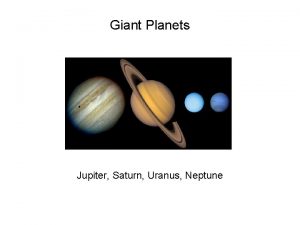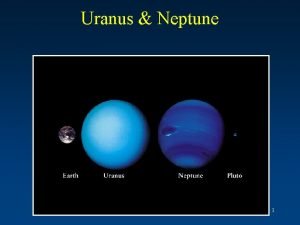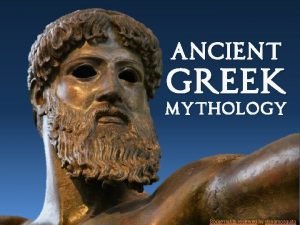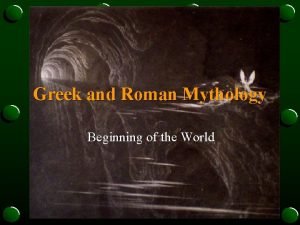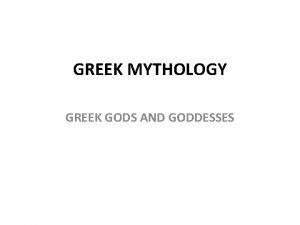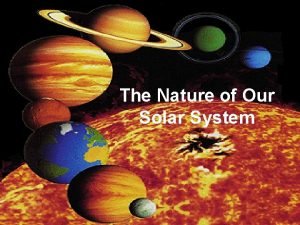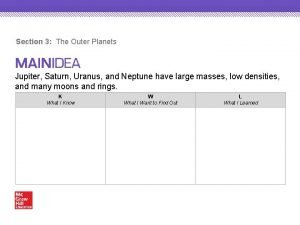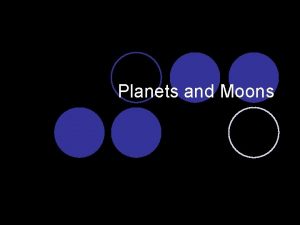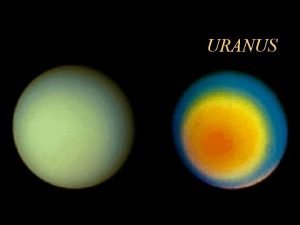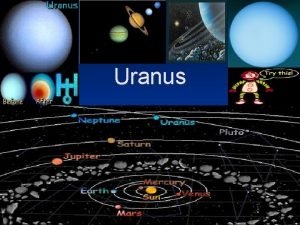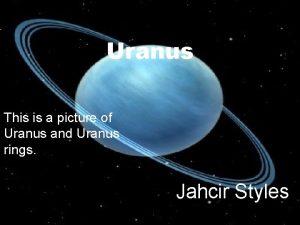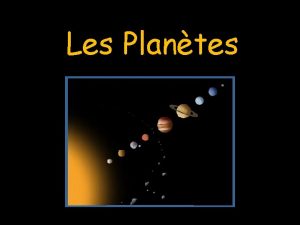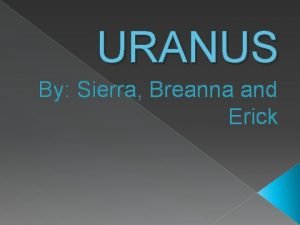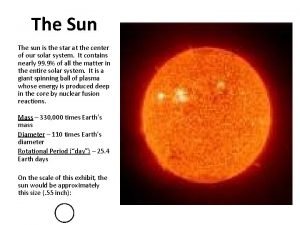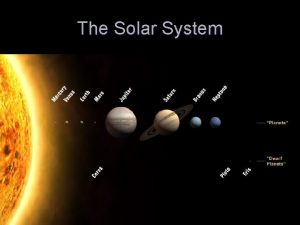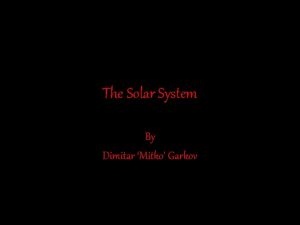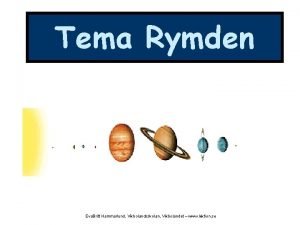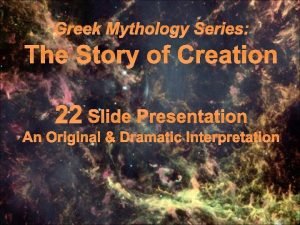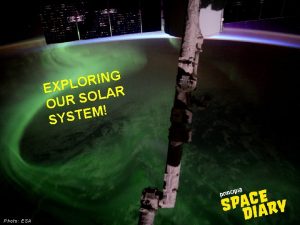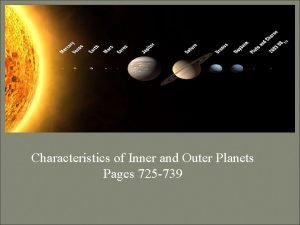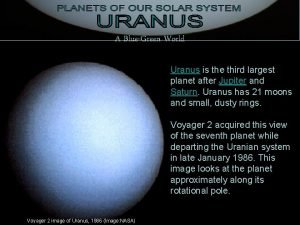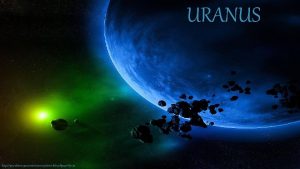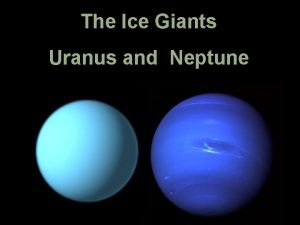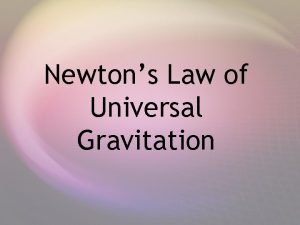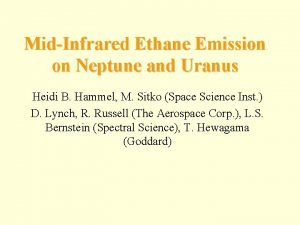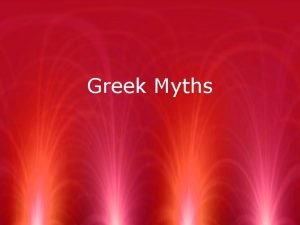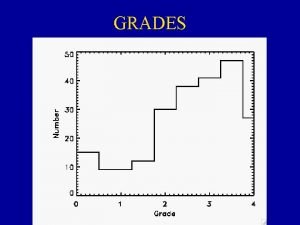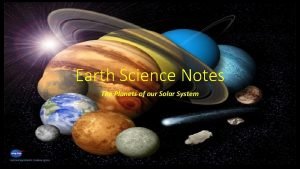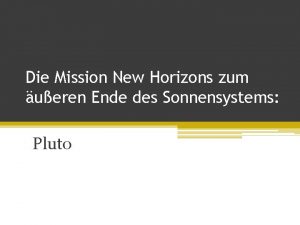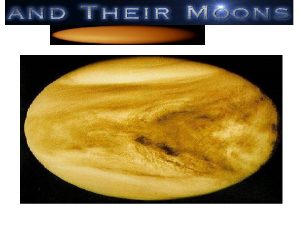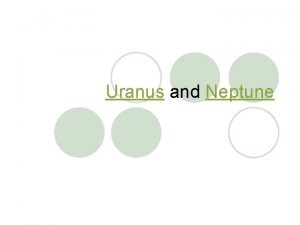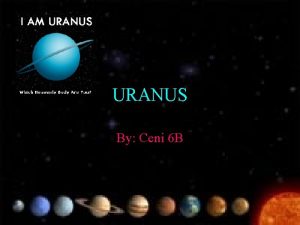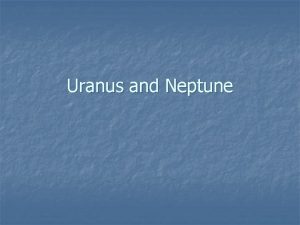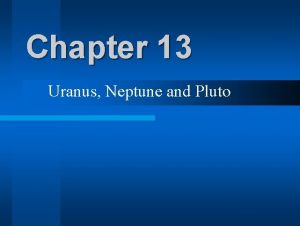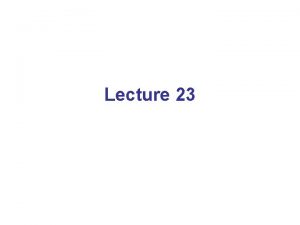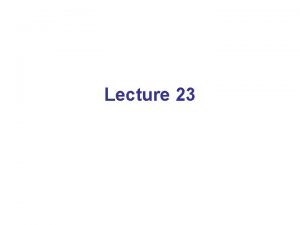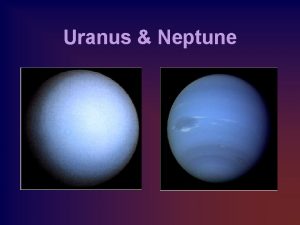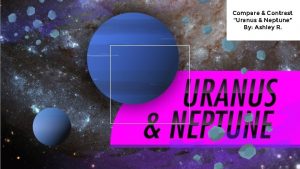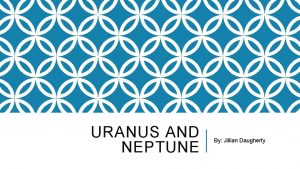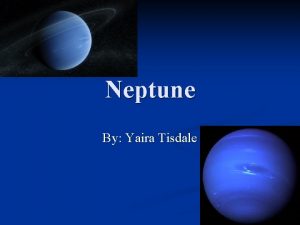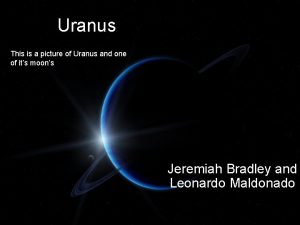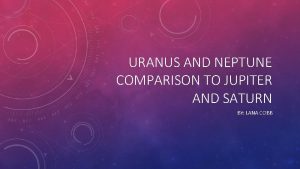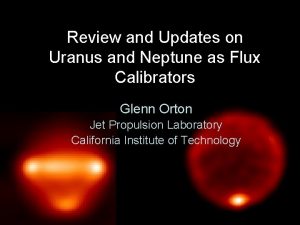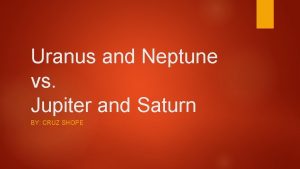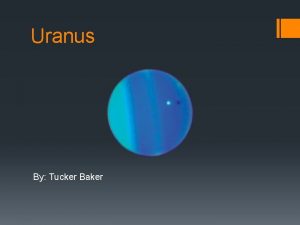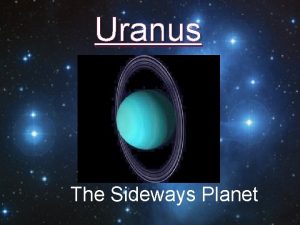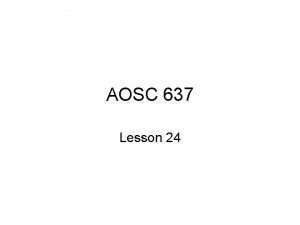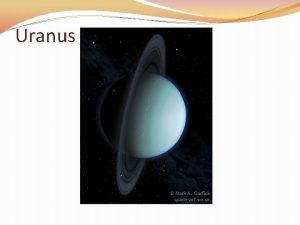The Formation of Uranus and Neptune and intermediatemass




































- Slides: 36

The Formation of Uranus and Neptune (and intermediate-mass planets) R. Helled Tel-Aviv University 1 Dec. 2013

Improve our understanding of the origin of our own solar system and low-mass planets Planet formation Physical and chemical properties of protoplanetary disks Uranus and Neptune are the Super-Earths/Mini-Neptunes of the Solar System

low/intermediate-mass planets are common What are they made of? How do they form? Where do they form?

How do planets like Uranus/Neptune form? What are Uranus and Neptune made of?

Uranus and Neptune: Internal Structure Basic idea of interior models: observations as constraints more accurate measurements less freedom in modeling ‘Standard’ modeling icy planets: 3 layers 1. Central Core (rocks) 2. Inner Envelope (ices) 3. Outer Envelope (‘atmosphere’ – H/He)

Basic Facts: Uranus: 14. 5 M @ 19. 2 AU Neptune: 17. 1 M @ 30 AU Composition: rocks, ices, H/He atmosphere Composition provides constraints on (1) the conditions in the solar nebula, (2) the planetary formation location and (3) formation timescale. Similarities: mass, radius, rotation, radial distance Differences: flux, tilt, atmospheric composition, satellite system

Observational Constraints Mass do we Radius. How (usuallywell equatorial) know those? Angular velocity Gravitational Moments (up to J 6) 1 bar Temperature Atmospheric composition (only sometimes…) (shape, MOI, magnetic fields dynamos)

Making an interior model Assumptions: spherical symmetry & hydrostatic equilibrium Interior parameters: density, pressure, temperature, luminosity, EOS Planetary basic equations: mass conservation, hydrostatic equilibrium, heat transport, energy conservation, EOS

Uranus and Neptune For Uranus and Neptune only J 2 and J 4 are available Why are they different? composition? heat transport? formation/evolution? The large error bars on J 2 n allow a large range of possible internal structures.

Uranus and Neptune For Uranus and Neptune only J 2 and J 4 are available Why are they different? composition? heat transport? formation/evolution? The large error bars on J 2 n allow a large range of possible internal structures.

Remember (!): Constraints on the density profile of the planets High-order harmonics provide information on outer regions Presence of a core is inferred indirectly from the model The core properties (composition, physical state) cannot be determined

Uranus and Neptune: Composition Gravity data is insufficient to constrain the planetary composition gray: H 2 O black: Si. O 2 Are Uranus and Neptune icy? Helled et al. , 2011 Reasons to believe they have water: (1) Magnetic fields – is it really? (2) Water is abundant at these distances – what about Pluto?

The Rotation Periods of Uranus and Neptune What are the rotation rates of Uranus and Neptune? • Complex multipolar nature of magnetic fields • Where are the magnetic fields generated?

Interior models with modified rotation Transition pressure (Gpa) black/gray - Voyager blue/turquoise - new P Tc (K), Pc (Mbar), Mcore /MEarth Mass fraction of metals in the outer envelope (Z 1) and in the inner envelope (Z 2) 3 -layer models of Uranus and Neptune Nettelmann, Helled, Fortney & Redmer, 2013.

Maybe Uranus and Neptune are not “icy” Uranus and Neptune might not be “twin planets”

Uranus and Neptune: Formation Planet Formation Disk mass and lifetime: Typical disk mass 0. 01 - 0. 1 M Disk observations: disk lifetime < 10 Myrs Density decreases with radial distance…

A typical protoplanetary disk

Formation of “Icy” Planets Standard Formation Model: Core accretion (Pollack et al. 1996) d. Mc/dt goes like ΣΩ Similar formation process like J&S but slower: “failed giant planets” On one hand have to form before the gas dissipates. On the other hand, should not become gas giant planets.

Formation via core accretion Giant planet formation in three steps: 1. Accretion of dust particles and planetesimals: build a core of a few M and a low-mass gaseous envelope. 2. Further accretion of gas and solids: the envelope grows faster than the core until the crossover mass is reached. 3. Runaway gas accretion with relatively small accretion of solids. see e. g. D’Angelo et al. 2011

A standard core accretion model for Jupiter’s formation @ 5. 2 AU, ΣS=10 g cm-2 @ phase 2 phase 1 isolation mass reached Pollack et al. , 1996. phase 3 runaway gas accretion Total Mass Gas Mass Core Mass

! n o ti is d s a p i s Note that: a g f (1)formation timescale o e m i t is long e h t (2)Mcore is 10 M , n o (3)Planetesimal size ends p e (4)we don’t get the d s s a correct final mass lm a Fin Pollack et al. 1996

Problems/Challenges: 1. Formation timescale for in situ formation 2. Getting Uranus-like final composition Possible Solutions: 1. 2. 3. 4. Formation closer to the sun (Nice Model) Disk physics/chemistry – disk evolution, enhancing the solids High accretion rates: dynamically cold planetesimal disk A combination…

U&N Formation: The Nice Model Formation at smaller radial distances solves the timescale problem & consistent with some features of the solar-system Difficulties: Cannot distinguish between Uranus and Neptune In many of the simulations the properties of the two outer planets (U, N) cannot be reconstructed see e. g. Thomess et al. 1999; 2002; Morbidelli et al. 2005; Tsiganis et al. 2005

Formation at shorter radial distances + solid-rich disk Formation at 12 and 15 AU Dodson-Robinson & Bodenheimer, 2010

Formation in a “dynamically cold” disk Fast growth if planetesimals are small. R. Rafikov (but see also Goldreich et al. 2003; 2004) The initially large planetesimals are unaffected by gas drag and beak into small planetesimals which can easily be accreted by a growing core high accretion rates also at large radial distances.

If accretion rates are high** can Uranus and Neptune form in situ? Explore various disk densities, accretion rates. **Rafikov, 2011; Lambrechts & Johansen, 2012

Preliminary results: 20 AU Helled & Bodenheimer, in prep. σs=0. 35 g cm-2 Σs=3. 5 g cm-2 σs=0. 7 g cm-2 Σs=1. 6 g cm-2; (d. Mc/dt)/20

Preliminary results: 15 AU Helled & Bodenheimer, in prep. σs=0. 55 g cm-2 Σs=5. 5 g cm-2

Preliminary results: 12 AU Helled & Bodenheimer, in prep. σs=0. 35 g cm-2

Preliminary results: 30 AU Helled & Bodenheimer, in prep. σs=0. 35 g cm-2

(Preliminary) Conclusions Uranus and Neptune could form in situ - the old timescale problem disappears! The challenge is to keep Uranus and Neptune small and from accreting too much gas and/or solids. Getting the correct gas-to-solid ratio is not trivial Explains the diversity of intermediate-mass exoplanets Helled & Bodenheimer, in prep.

An alternative model Formation by disk instability at large radial distance followed by core formation and gas removal (e. g. , Boss et al. 2002; Nayakshin, 2011; Boley et al. , 2011) However 1. Ice grains might not settle all the way to the center and in addition 2. Strongly depends on grain size and the removal of the envelope 3. Still work in progress… L. Mayer

Connect Internal Structure with Origin Despite the similar masses Uranus and Neptune they differ in other physical properties. What are the causes for these differences? The difference could be a result of post formation events such as giant impacts.

Giant impacts: tilt, internal flux and atmospheric composition, satellite formation Neptune: Radial Collision Enough energy to mix the Core: Mixed and adiabatic interior, efficient cooling Podolak & Helled, 2012 Stevenson, 1986 Uranus: Oblique Collision Angular momentum deposition: Core (MOI) convection is inhibited slow cooling, tilt

Summary & Future Research How do icy planets form? What are the compositions and internal structures of Uranus and Neptune? Improved understanding of planetesimal formation and their properties; disk evolution Connect interior models with planetary formation and evolution models Space mission to Uranus and/or Neptune Characterization of low-mass extrasolar planets

Thank You!
 Neptune uranus size comparison
Neptune uranus size comparison Circumference of uranus in km
Circumference of uranus in km 9.34.t - lesson: uranus, neptune & pluto assessment
9.34.t - lesson: uranus, neptune & pluto assessment Titanomach
Titanomach Hundred handed giants greek mythology
Hundred handed giants greek mythology Gaea greek god
Gaea greek god Tyche family tree
Tyche family tree Formation initiale vs formation continue
Formation initiale vs formation continue Difference between solar and lunar eclipse
Difference between solar and lunar eclipse Plantami
Plantami Uranus was discovered accidentally in 1781
Uranus was discovered accidentally in 1781 Features of mercury planet
Features of mercury planet Satellite image of uranus
Satellite image of uranus Uranus god
Uranus god 17th hour of the day
17th hour of the day Picture of uranus
Picture of uranus Uranus plante
Uranus plante Greek mythology family tree chaos
Greek mythology family tree chaos How many moons does uranus have
How many moons does uranus have Uranus distance from sun
Uranus distance from sun Neptune facts
Neptune facts Tempreture of venus
Tempreture of venus Jordår
Jordår What is the largest planet known
What is the largest planet known Khaos greek god
Khaos greek god Uranus distance from sun
Uranus distance from sun Characteristics of jupiter planet
Characteristics of jupiter planet Uranus blue green appearance is caused by
Uranus blue green appearance is caused by Uranus founder
Uranus founder Coldest planets
Coldest planets Uranus requires 84 years
Uranus requires 84 years Xray uranus
Xray uranus Uranus angered gaea by
Uranus angered gaea by Uranus
Uranus Uranus planeet
Uranus planeet Uranus steckbrief
Uranus steckbrief Atmosphere
Atmosphere
